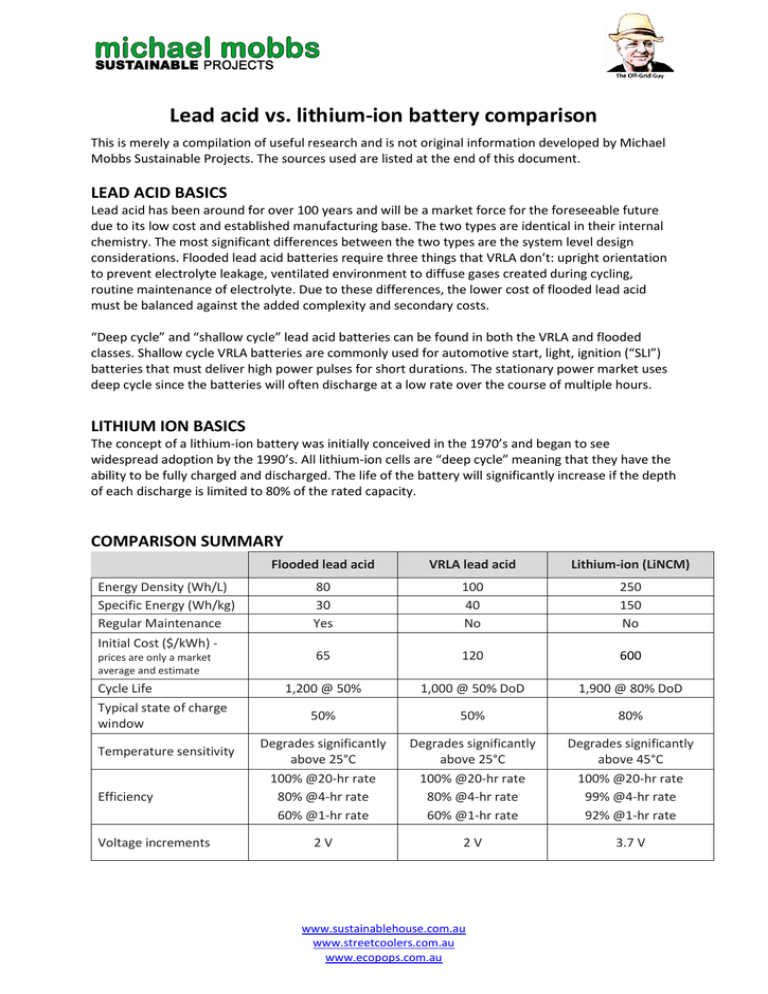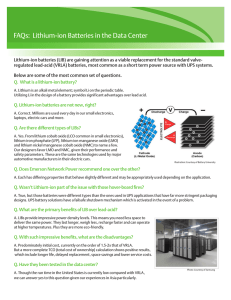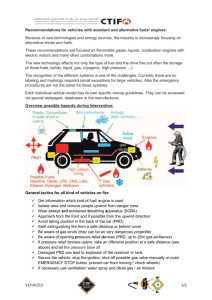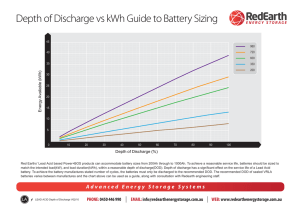Lead acid vs. lithium-ion battery comparison
advertisement

Lead acid vs. lithium-ion battery comparison This is merely a compilation of useful research and is not original information developed by Michael Mobbs Sustainable Projects. The sources used are listed at the end of this document. LEAD ACID BASICS Lead acid has been around for over 100 years and will be a market force for the foreseeable future due to its low cost and established manufacturing base. The two types are identical in their internal chemistry. The most significant differences between the two types are the system level design considerations. Flooded lead acid batteries require three things that VRLA don’t: upright orientation to prevent electrolyte leakage, ventilated environment to diffuse gases created during cycling, routine maintenance of electrolyte. Due to these differences, the lower cost of flooded lead acid must be balanced against the added complexity and secondary costs. “Deep cycle” and “shallow cycle” lead acid batteries can be found in both the VRLA and flooded classes. Shallow cycle VRLA batteries are commonly used for automotive start, light, ignition (“SLI”) batteries that must deliver high power pulses for short durations. The stationary power market uses deep cycle since the batteries will often discharge at a low rate over the course of multiple hours. LITHIUM ION BASICS The concept of a lithium-ion battery was initially conceived in the 1970’s and began to see widespread adoption by the 1990’s. All lithium-ion cells are “deep cycle” meaning that they have the ability to be fully charged and discharged. The life of the battery will significantly increase if the depth of each discharge is limited to 80% of the rated capacity. COMPARISON SUMMARY Energy Density (Wh/L) Specific Energy (Wh/kg) Regular Maintenance Initial Cost ($/kWh) prices are only a market average and estimate Cycle Life Typical state of charge window Temperature sensitivity Efficiency Voltage increments Flooded lead acid VRLA lead acid Lithium-ion (LiNCM) 80 30 Yes 100 40 No 250 150 No 65 120 600 1,200 @ 50% 1,000 @ 50% DoD 1,900 @ 80% DoD 50% 50% 80% Degrades significantly above 25°C 100% @20-hr rate 80% @4-hr rate 60% @1-hr rate Degrades significantly above 25°C 100% @20-hr rate 80% @4-hr rate 60% @1-hr rate Degrades significantly above 45°C 100% @20-hr rate 99% @4-hr rate 92% @1-hr rate 2V 2V 3.7 V www.sustainablehouse.com.au www.streetcoolers.com.au www.ecopops.com.au LIFE CYCLE AND PERFORMANCE Lithium-ion has significantly higher cycle life than lead acid in deep discharge applications. The disparity is further increased as ambient temperatures increase. The cycle life of each chemistry can be increased by limiting the depth of discharge (DoD), discharge rate, and temperature, but lead acid is generally much more sensitive to each of these factors. In the figures below, AGM refers to a lead acid battery. In hot climates where the average temperature is 33°C, the disparity between lithium-ion and lead acid is further exacerbated. The cycle life for lead acid (flooded and VRLA) drops to 50% of its moderate climate rating while lithium-ion will remain stable until temperatures routinely exceed 49°C. Analyses indicate that lithium-ion has an 18% higher lifetime cost when compared to lead acid in moderate climates, but is much more cost effective in hot climates. There is a significant area of the world that sees average temperatures high enough to decrease the life of lead acid batteries. A factor not represented in the figure is that the battery systems are often housed in enclosures that see internal temperatures 10°C higher than the air temperature due to solar insolation, which would further decrease the performance of lead acid. The average temperature is also not completely representative of how much time is spent at extreme temperatures where the degradation accelerates in lead acid systems (e.g. one hour spent at 40°C and one hour spent at 20°C has a worse impact on the battery compared to two hours spend at 30°C) www.sustainablehouse.com.au www.streetcoolers.com.au www.ecopops.com.au Another critical consideration for lead acid is how long the system will take to discharge. The shorter the discharge period, the less capacity is available from the lead acid battery. A 100Ah VRLA battery will only deliver 80Ah if discharged over a four hour period. In contrast, a 100Ah lithium-ion system will achieve over 92Ah even during a 30 minute discharge. As shown in the figure below, this condition makes lithium-ion very well suited for applications where full discharge occurs in less than eight hours. ENVIRONMENTAL IMPACT Lead acid batteries compare poorly to lithium-ion with regards to environmental friendliness. Lead acid batteries require many times more raw material than lithium-ion to achieve the same energy storage, making a much larger impact on the environment during the mining process. The lead processing industry is also very energy intensive, leading to large amounts of pollution. Although lead is highly hazardous to human health, the manufacturing methods and battery packaging make the human risk negligible. Lithium is not without its own environmental problems. The major components of a lithium-ion cell require the mining of lithium carbonate, copper, aluminium, and iron ore. Lithium mining specifically is resource intensive, but lithium is only a minor portion of the battery cell by mass, so the aluminium and copper environmental impacts are much more significant. The lithium-ion recycling industry is only in its infancy right now, but the cell materials have shown high ability for recovery and recyclability, so it is expected that lithium-ion recycling rates will rival lead acid. SAFETY Lead acid and lithium-ion cells are both capable of going into “thermal runaway” in which the cell rapidly heats and can emit electrolyte, flames, and dangerous fumes. The likelihood and consequences of an event are higher for lithium-ion as it has a higher amount of energy in a smaller volume. Multiple cell and pack safety precautions are taken to prevent trigger events, such as short circuits and overheating, but incidents still occur.i www.sustainablehouse.com.au www.streetcoolers.com.au www.ecopops.com.au LIFE CYCLE ANALYSIS A study was performed by Stanford scientists to calculate the carbon footprint of grid-scale battery technologies. To quantify the long-term energetic costs, Barnhart and Benson came up with a new mathematical formula they dubbed ESOI, or energy stored on investment. "ESOI is the amount of energy that can be stored by a technology, divided by the amount of energy required to build that technology," Barnhart said. "The higher the ESOI value, the better the storage technology is energetically." Of the five battery technologies they researched, Lithium-ion batteries were the best performers, with an ESOI value of 10. Lead-acid batteries had an ESOI value of 2, the lowest in the study. "That means a conventional lead-acid battery can only store twice as much energy as was needed to build it," Barnhart said. "So using the kind of lead-acid batteries available today to provide storage for the worldwide power grid is impractical." Additionally, the best way to reduce a battery's long-term energetic costs, he said, would be to improve its cycle life – that is, increase the number of times the battery can charge and discharge energy over its lifetime. Lithium-ion was the best at 6,000 cycles, while lead-acid technology is at the bottom, achieving a mere 700 cycles.ii ADDITIONAL COMPARISON TABLE www.sustainablehouse.com.au www.streetcoolers.com.au www.ecopops.com.au iii COMMENTS FROM OUR COLLEAGUES AT OFF-GRID ENERGY The tables indicate very low cycle life for lead acid. This will depend very heavily on how the battery is cycled. So for instance under a 20% depth of discharge regime, we expect our lead acid systems to achieve over 7,000 cycles. This is why good design and good programming is so important. Similarly if we only cycle lithium at 50% compared to 80% it will last much longer according to the manufacturer specifications. The problem here is that there really isn’t “on the ground” evidence for lithium in these applications, so it remains to be seen how lithium will perform over time in real situations (whether we will see 20 years + from them). It’s important to understand that due to having less total kW storage for a given lithium off grid system design (due to the ability to cycle at higher rates), there is less autonomous capacity in the lithium battery bank. This means that the system will rely on regular PV charging cycles and if there is no sun for a lengthy period, a generator to underpin the power delivery. Sealed gel on the other hand, may only be cycled under normal circumstances by 20% (100 down to 80%) but there is a significant amount of power left in the bank to be drawn upon if needed under adverse conditions. This autonomy is very important and should be considered carefully for Kylie’s project, as without a generator there is a real risk of being short on power with lithium storage at times. Of course we could mitigate this, by increasing the number of lithium storage modules, but then the economic case vs lead acid really starts to move out of the ball park of $ for $ comparison. i http://www.altenergymag.com/content.php?post_type=1884#_edn2 http://news.stanford.edu/news/2013/march/store-electric-grid-030513.html iii http://batteryuniversity.com/learn/article/whats_the_best_battery ii www.sustainablehouse.com.au www.streetcoolers.com.au www.ecopops.com.au


